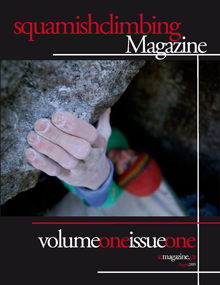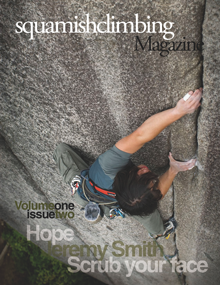On Friday, February 20th, the Centennial Theatre in North Vancouver will host the Vancouver International Mountain Film Festival featuring speaker Will Gadd and the film Frozen Titans. Frozen Titans features Will Gadd climbing Helmcken Falls in Wells Gray Provincial Park.
The waterfall at Helmcken Falls created some massive challenges, both for the climber and the film crew. This film was produced by Reel Water Productions, a local production company based in Squamish, BC that has created huge momentum over the past few years. Squamish Climbing Magazine thought it best to check in with Dave Pearson on the Titan shoot as well as other projects they have going on. Dave is one of the kindest guys around and here is what he had to say.
Be sure not to miss The Making of Frozen Titans in the middle of this article.
Hi Dave, Thanks for chatting with us. How are you doing?
Hey Tim, Doing well. Glad to be back home in Squamish for a while.
You guys have been travelling a lot lately.
Yeah we have been on the road a lot over the last few months. Actually its been a busy few years now.
One of your films, Frozen Titans, will be featured at VIMFF. Can you tell us a little about the shoot?
We started shooting with Will and his team back in the summer of 2013. We wanted to get into Helmcken and really see the place before the ice formed. It gave us a lot of the information we needed to go back there in Jan of 2014 to start filming them in the winter. It was colder than I think anyone really expected. This was great to a point, but then it started to get brutal. Being out all day hanging in a harness next to a waterfall in -30c wore everyone down. I think we were in there filming for 21 straight days by the time we wrapped.
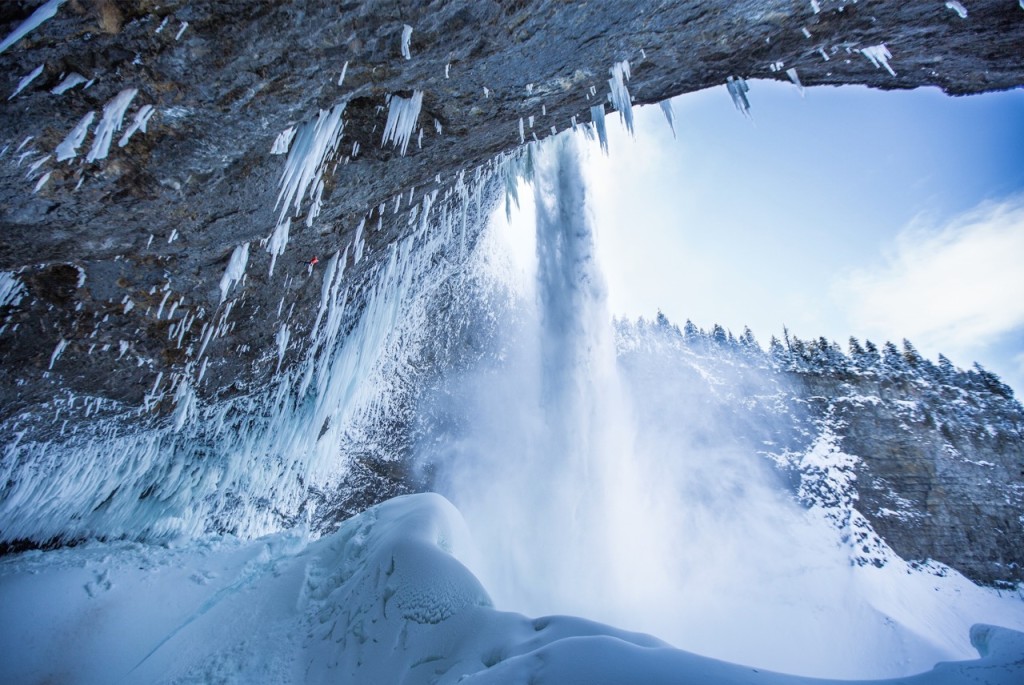
Helmcken Falls. Still courtesy of Pablo Durana ©
What was the most challenging thing about shooting Helmcken Falls?
The environment is really hard for filming. There are so many objective hazards that you can only really operate in areas that have been worked on until they are safe. A lot of the time you would do this by picking up debris off the ground and throw it at ice in the roof to knock it off and clear a path to a “safe zone”. We would have to clear tonnes of ice to get to a new camera position. Keeps you warm doing it though.
On the wall the the real challenge was the spray. On the upper pitches you would be lucky to get 10 seconds of shooting before the lens would completely freeze over and you would have to try and chip it off with whatever was handy, usually the lens cap. Conditions up there sucked. Amazingly with all that equipment the only thing that got dropped into the ice cone was Wills radio.
Your homebase is in Squamish, BC. What gave you the idea to station the production company here?
The amount of adventure-sport focused production companies across BC but especially in the Sea to Sky corridor is amazing. This has become one of the major production hubs for the genre. Bryan Smith founded Reel Water Productions years before I arrived in Squamish. He and Christian Begin were out there doing some really cool projects that covered a whole gamut of sports and environments. The variety of stories they were working on and their focus on storytelling is what set them apart. A few years later I was lucky enough to be working with Reel Water on projects like Helmcken and Rockies.
You recently filmed Will Gadd and Gavin McClurg on their cross country paragliding traverse of North America. What was it like filming this epic adventure?
The Rockies Traverse was a standout project for last year. It was a solid objective with some really sketchy moments. When you see the terrain that Will and Gavin were flying through it becomes apparent that they were really hanging it out there. Those guys are next level pilots and what they achieved was impressive.
Filming it was logistically complex. We had a lot of moving parts, a very defined shooting window and only about a month in preproduction to pull it together. We worked closely with the Provincial Parks service to permit the entire 700km flight path not only for Will and Gavin but also the Heli. We worked with Kelsey Wheeler at Talon Helicopters on getting an A-Star for 3 weeks with a GSS Gimbal for the aerial footage. Once the mission started it was non-stop. We would film them from the air during the day then get dropped off and camp with them when they landed, and repeat for 3 weeks. Having that kind of access to Will and Gavin was the only way we were able to cover the story as it happened.
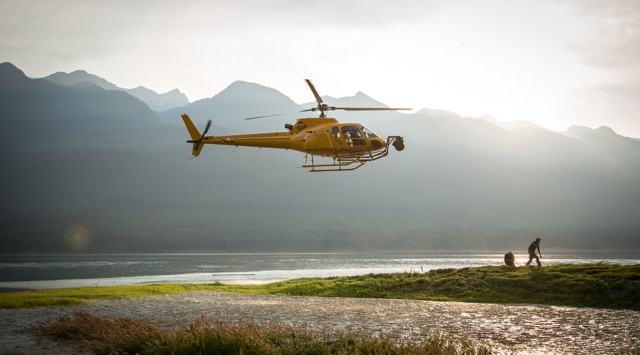
Helicopter with camera on cross country shoot. Still courtesy of Pablo Durana ©
How long did you fly around in helicopters each day?
It depended on the day. The days Will and Gavin were grounded due to weather halfway down Kinbasket Lake we barely used any time, then on some of the bigger final flights we used 6-8hrs of heli-time a day. All up I think we chewed through 10,000 litres of Jet A fuel over the 3 weeks.
I have to ask about your most recent project, filming Will Gadd on Niagara Falls. What did the planning process look like for this adventure in such a well-used area?
Niagara was a really interesting project to work on. The challenge was access and permitting. Will and RedBull worked for close to a year to gain approval for the climb. Bryan and I had been closely involved in production planning in the last 6 months. There were a lot of moving parts working together to make sure everything went smoothly on the day. Between the climbing crew, the safety crew, the film crew, NY Parks Police and other emergency service members there would have been close to 40 people involved to enable a 3hr shoot window on send-day. It went amazingly smoothly and everyone got out safe. Without the level of planning that was put into that project it could have quite easily failed.
Is there a lot of bureaucracy in these big shoots?
Niagara stands out from all other projects in this regard as it is one of North Americas most iconic, visited and regulated landmarks. Every project presents us with different challenges. What we have found is that by working closely with the parks or city administrators on correctly permitting our shoots we have been able to build a track record of doing projects the right way. This is one of the biggest things you can have going for you when you are asking them for something that is out-of-the-box like trying to permit a 700km swathe of the Rockies for helicopter access.
I heard that getting the footage out for Niagara Falls was a bit of a rush because of a rogue filmer. Can you tell us a bit about that?
As a film crew hanging over the edge of a major tourist attraction its hard to go unnoticed. We kept a lid on the whole project for as long as possible to avoid causing crowds. The day before send day a Niagara local on the Canadian side managed to get some footage of Will rapping the line and scoping it out. He quickly passed this to the local news stations,which then went to national, then international news agencies and we had to react pretty quickly to make sure that we got our footage out to them first. We setup an edit suite in a casino conference room and worked around the clock to get it finished in time. Luckily we did and Will’s Niagara story travelled internationally.
You have been hanging with Will Gadd a lot. Filming a guy day in day out, do you get to know him on a personal level?
Yeah, that is a lot of projects to be doing with the same guy in a single year. Especially when you think that Bryan and I have to listen to his voice for another 3 months during the edit of these shows. Luckily we all get on great together which is important because it is often a very stressful environment with long days for weeks at a time. By now i think everyone knows where the limits of everyone else’s patience are. The best way to find those limits is to go past them. I think we all got that sorted out in Helmcken. Will has been great to work with and we have been able to get out and climb together outside of projects. He has to be one of the most committed athletes I’ve ever met.
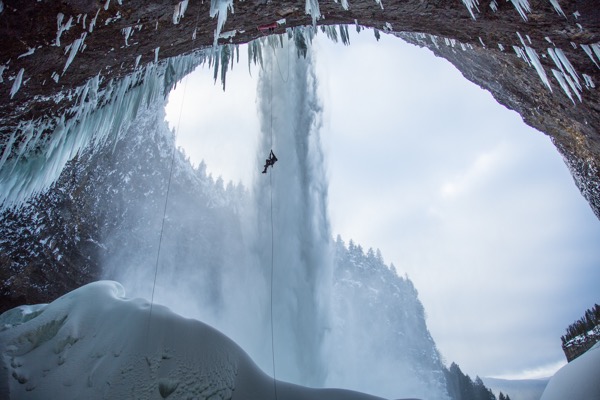
Jugging the line at Helmcken. Still courtesy of Pablo Durana ©
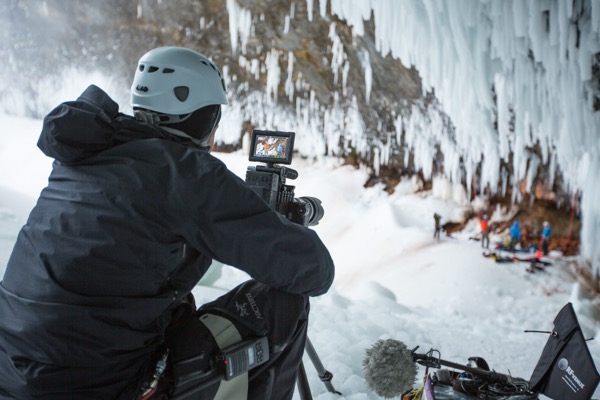
Behind the lens. Still courtesy of Pablo Durana ©
What continues to challenge you guys as you get ready for a shoot?
Finding the right stories to chase. That would have to be one of the most challenging yet rewarding parts of the process. If you find a story and characters that you are psyched on from the beginning it makes the whole production easier. These projects often involve a high degree of suffering, so you better believe in what you are doing there. When it comes to researching stories we cast our net pretty wide. The right project is a perfect storm of: great protagonists, a solid objective, and the ability to be there with them to cover the story well.
You recently became a father. How has that impacted your adventures?
My equation changed, thats for sure. I love what I do but the reality is you are standing next to an athlete filming them because they are doing something that is inherently dangerous. Both Bryan and I would be lying if we said their hadn’t been close calls over the last few years. I think adding a kid to the mix forces me to take a step back and really analyze how I assess risk personally. I realized that for most of my life I have put too much faith into the the risk assessment of others around me.
Thanks Dave for answering all our question. Friday night is surely not to be missed. Enjoy the time home brother! Squamish Climbing Magazine has thoroughly enjoyed covering the Vancouver International Film Festival this year. Thanks to all those who made it possible and special thanks to Tom Wright for helping us be a part of it.
For tickets for Friday’s event, please click here.











